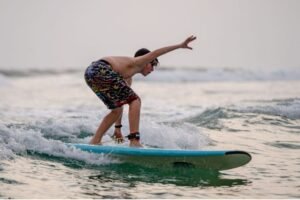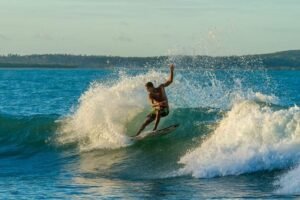
Women in Big Wave Surfing: Breaking Barriers and Making Waves. Big wave surfing has long been considered a male-dominated sport. But, women have been making their mark on the sport for decades. From overcoming societal norms to carving out a space in extreme surf breaks, the history of women in big wave surfing is an inspiring. Inspiring tale of resilience, courage, and triumph. This article takes you through the milestones of women in big wave surfing, highlighting key figures, breakthroughs, and the ongoing fight for equality in the sport.
The Early Struggles: Women and Big Wave Surfing
The history of women in surfing is rich, stretching back to ancient Polynesian times when women rode waves alongside men. However, in modern times, surfing became more commercialized. Big wave surfing, in particular, became dominated by men. Big wave surfing spots like Mavericks, Jaws, and Teahupo’o were considered dangerous and male-dominated, with women rarely seen in the lineup.
For years, women faced significant challenges in entering the big wave scene. Gender inequality meant that women weren’t often allowed to participate in the larger competitions. The idea of women surfing massive waves was often met with skepticism.
The Pioneers: Sarah Gerhardt and Keala Kennelly
One of the first women to break through was Sarah Gerhardt. Who made history in 1999 by surfing Mavericks, one of the most dangerous surf spots in the world. Her achievement was groundbreaking. No woman had surfed waves of that size before. Sarah’s fearless approach proved that women had the skill and courage to compete in big wave surf breaks.
Following in Sarah’s footsteps, Keala Kennelly, a Hawaiian surfer, also made her name in the big wave scene. Known for her performance at Teahupo’o, Keala became one of the top female big wave surfers, earning respect for her powerful rides on massive waves. She became the first woman to win the Barrel of the Year award at the Big Wave Awards in 2016. Thats a historic moment in the sport’s history.
Breaking Through: Maya Gabeira’s Record-Breaking Waves
As women like Sarah Gerhardt and Keala Kennelly paved the way, Maya Gabeira emerged as one of the most significant figures in big wave surfing. A Brazilian surfer, Maya made headlines for her performance at Nazaré, Portugal. That spot known for producing the largest waves on the planet.
In 2013, Gabeira nearly lost her life at Nazaré when she was knocked out by a giant wave. Despite the near-fatal experience, she returned in 2020 to ride a 73.5-foot wave. It setting a Guinness World Record for the largest wave ever surfed by a woman. Maya’s dedication, resilience, and talent have made her a role model for women in extreme sports.
The Fight for Equality in Big Wave Surfing
While individual women were achieving incredible feats, the sport itself was slow to offer equal opportunities for female surfers. For many years, women were excluded from major big wave competitions. They had limited access to the resources, sponsorships, and media coverage that male surfers enjoyed.
In 2016, Paige Alms made history by winning the first-ever Women’s Big Wave Championship at the Peʻahi Challenge in Maui, Hawaii. Paige’s victory helped push for more inclusivity in big wave competitions. But it wasn’t until 2018 that the World Surf League (WSL) made a significant move toward gender equality by introducing equal prize money. For men and women in all of their events was equal.
This milestone was a massive win for the women’s surfing community. Ensuring that female surfers were treated fairly and given the recognition they deserved.
Women’s Representation in Big Wave Surfing
With increasing media coverage and a growing community of female surfers, women in big wave surfing began to receive the attention they had long been denied. Documentaries like Girls Can’t Surf and She Is the Ocean helped highlight the struggles and achievements of female surfers. Further, pushing the narrative of women in extreme sports.
Social media also played a pivotal role in elevating the visibility of women surfers. Platforms like Instagram allowed athletes to connect directly with fans, share their journeys, and showcase their skills. Female big wave surfers were no longer hidden in the shadows—they were stars in their own right.
The Future of Women in Big Wave Surfing
Today, women’s participation in big wave surfing continues to grow. The next generation of female surfers is pushing boundaries even further. Bianca Valenti, Andrea Moller, Emi Erickson, and Justine Dupont are just a few of the talented women riding the biggest waves on the planet. They are not only athletes but also advocates for gender equality. Tehy often pushing for equal opportunities, more coverage, and safer training practices for all surfers.
With more women entering the sport from diverse backgrounds, including countries like South Africa, Indonesia, and India, big wave surfing is becoming more inclusive. As more women charge massive waves, the landscape of the sport is changing, and the barriers to entry are being dismantled.
Equal Pay and Recognition in Big Wave Competitions
One of the most significant changes for women in big wave surfing came in 2018 when the WSL officially announced equal prize money for both men and women. This decision was a game-changer and reflected the growing recognition of female surfers’ contributions to the sport. The move not only gave women the financial rewards they deserved but also acknowledged their efforts on a global stage.
Women Changing the Landscape of Big Wave Surfing
The history of women in big wave surfing is one of overcoming challenges, breaking records, and rewriting the rules of what’s possible. Female surfers like Sarah Gerhardt, Keala Kennelly, Maya Gabeira, and Paige Alms have shown the world that women can ride massive waves. Just as fearlessly as men. They’ve fought for equal recognition and opportunities, paving the way for the next generation of female surfers. As the sport continues to evolve, one thing is certain: women in big wave surfing aren’t just riding waves. They’re reshaping the future of the sport, creating a more inclusive, equal, and empowering environment for everyone involved.





